
This story was updated at 3:55 PM
Today, the Environmental Protection Agency (EPA) has announced the first-ever national drinking water standard for harmful per and poly-fluoroalkyl substances known as PFAS, man-made ‘forever chemicals’ with the aim of reducing exposure to the lowest levels that are feasible levels nationwide.
The federal agency stated that the new legally-enforceable drinking water standard will protect 100 million people from PFAS exposure and tens of thousands from serious illness.
Exposure to PFAS has been linked to cancer, impacts to the heart and liver as well as immune and development damage to infants and children.
The new rule will set limits for six PFAS known to occur individually five individual PFAS: PFOA, PFOS, PFNA, PFHxS and HFPO-DA, also known as “GenX Chemicals” and will establish a limit for mixtures of any two or more or four PFAS: PFNA, PFHxS, PFBS and GenX Chemicals.
These new standards will require public water systems to monitor and reduce the levels of PFAS and notify the public of any exceedances of those levels.
The public water systems will have three years to complete initial monitoring for the chemicals.
Ali Zaidi, White House National Climate Advisor stated that the federal government will also provide $1 billion through President Biden’s Investing in America Agenda, to address PFAS remediation nationwide, including here in Arizona.
“This is part of funding that flows routinely from the EPA to environmental agencies like ADEQ to stand up water infrastructure financing capability,” Zaidi said.
ADEQ refers to the Arizona Department of Environmental Quality.
The newly available funding is part of the $9 billion allocated through the Bipartisan Infrastructure Law (BIL) to assist communities in addressing PFAS contamination and other emerging contaminants.
It also aligns with President Biden’s Cancer Moonshot initiative, aimed at preventing over 4 million cancer deaths by 2047.
Zaidi added that the White House worked with the EPA which led the science-based process to update the standards, along with other federal agencies to improve its “PFAS posture.”
“We know that this is a task that requires partnerships and we’re very grateful for the partnership with Governor Hobbs, with the state of Arizona to get the job done,” Zaidi said.
He noted that work remains ongoing to ensure the enforcement of these new regulations and that polluters are held accountable.
Ahead of today’s announcement, the EPA released updated guidelines on the proper destruction, disposal or storage of PFAS yesterday, to help decision makers in prioritizing the use of technologies with the lowest potential for environmental release.
EPA estimates between 6-10% of 66,000 public drinking water systems will have to take action to meet the new standards.
Since 2018, the ADEQ has launched a statewide effort to test public water systems for 29 different types of PFAS that have been published in an interactive data map on their website.
ADEQ states, “As of April 10,2024, 83% of all Arizona public water systems subject to the PFAS final rule have been tested for PFAS. Approximately 10% of systems tested to date have found PFAS at a level higher than an MCL. Many of these systems have already taken actions to reduce customers’ PFAS exposure.”
MCL stands for Maximum Contaminant Levels.

By submitting your comments, you hereby give AZPM the right to post your comments and potentially use them in any other form of media operated by this institution.